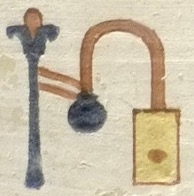



This page displays details of the selected Monument. Click on the Monument number to list all individual signs ("occurrences") recorded from that object or structure.
Monument : Sarenput II
Period : Dynasty XII
Reign(s) : Amenemhat II
High Date : 1911
Low Date : 1877
Monument type : Private Tomb
Localisation or provenance : Elephantine
References : PM V, 233-234; Müller (1940). Photos www.osirisnet.net.
Sarenput II, the grandson of Sarenput I, was a powerful nomarch under Amenemhat II, bearing the titles “Overseer of the prophets of Khnum of Elephantine” and “Commander of the frontier garrison of the Southern Lands”. Despite his elevated status, however, he was obviously under the influence of his pharaoh, going so far as to have a second name Nubkaurê-nakht, meaning “Amenemhat is strong”. He even had this second name written using the cartouche to enclose the pharaoh’s “Son of Rê” name Nubkaurê, possibly as a way of inflating his own importance. His tomb (see plan in PM V, 230, 31) contains some well-preserved polychrome inscriptions, especially in the three-sided niche at the north-western end. As no high quality colour photos were available, use was made of the sign list in Müller (1940, 109-111). However, having obtained some photos from the “Osirisnet” website (many thanks to Dr. Thierry Benderitter), it soon became clear that Müller’s list contains several errors, such as signs omitted (e.g. D1 the head in profile) and signs wrongly labelled (e.g. W17 a stand with three jars, in place of W18 which has four). Consequently, all signs have been checked against the photos and rectified where necessary. One sign that is unclear was recorded by Müller as W8 - a deformation of a granite bowl. It seems here to be some sort of matting (blue), rolled up and tied in the middle and at each end with yellow bands. The sign appears clear : it is the wickerwork frail V32, often confused with W8 (EG 526; 528). The inscription provides the only occurrence of the sign E26 an elephant, which is coloured dark grey : an unusual colour for hieroglyphs, but an understandable one in the context of a naturalistic image. On the south-west wall of the vaulted corridor, there is an unfinished inscription, where the colours used are sometimes highly unusual (e.g. D54 the walking legs, which are blue instead of the ubiquitous red). Some of the signs have not always been painted (e.g. M17 the reed, which is sometimes coloured, but in yellow instead of the canonical green and blue). The quality of execution and the choice of colours points to the work of an inexperienced scribe-painter. Consequently, this particular inscription has not been included in the database corpus. Apart from those in the unfinished inscription, the colours used show very little deviation from the canon, unlike for the tomb of Sarenput I. This probably reflects the increased power wielded by Amenemhat II and the subsequent influence of the centralised elite on high culture.